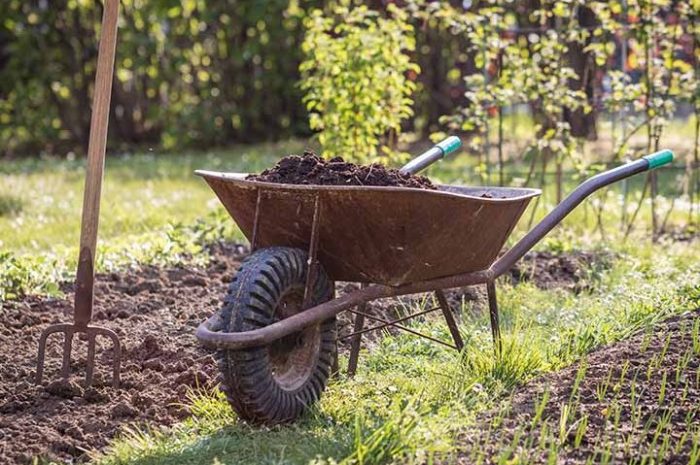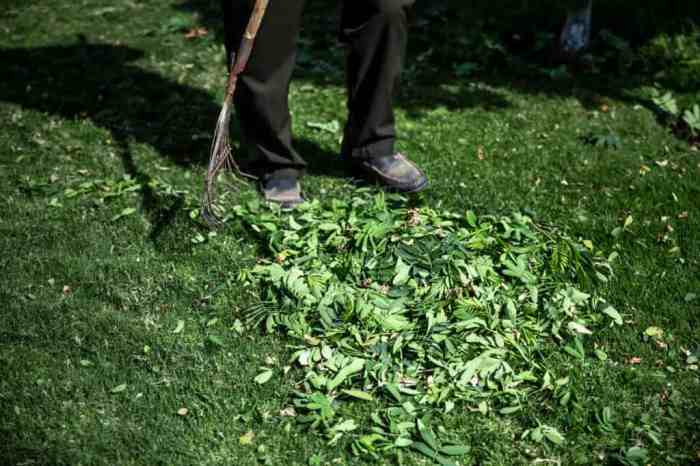Grass clippings are placed in a bin where they decompose, a process that unlocks a wealth of benefits for soil health, fertility, and environmental sustainability. This article delves into the intricacies of grass clippings decomposition, exploring its mechanisms, advantages, methods, considerations, and applications.
Through natural decomposition, microorganisms break down grass clippings, releasing essential nutrients and organic matter that enhance soil structure and fertility. This process not only reduces waste but also conserves resources, contributing to a greener and more sustainable environment.
Grass Clippings Decomposition Process

Grass clippings decompose naturally through a process involving microorganisms, primarily bacteria and fungi. These microorganisms break down the organic matter in the clippings, converting it into simpler compounds that can be absorbed by plants.
Role of Microorganisms
- Bacteria initiate the decomposition process by breaking down complex carbohydrates and proteins into simpler sugars and amino acids.
- Fungi then take over, further decomposing these compounds into even simpler forms, such as carbon dioxide and water.
Factors Affecting Decomposition Rate, Grass clippings are placed in a bin where they decompose
- Temperature:Higher temperatures accelerate microbial activity, leading to faster decomposition.
- Moisture:Adequate moisture is essential for microbial growth and activity.
- Oxygen Availability:Aerobic microorganisms require oxygen for decomposition, while anaerobic microorganisms can decompose in oxygen-deprived environments.
Benefits of Grass Clippings Decomposition: Grass Clippings Are Placed In A Bin Where They Decompose

Soil Health and Fertility
- Decomposed grass clippings add organic matter to the soil, improving its structure and water-holding capacity.
- They release nutrients, such as nitrogen, phosphorus, and potassium, which are essential for plant growth.
- They support beneficial soil microorganisms that enhance nutrient cycling and suppress pathogens.
Environmental Benefits
- Waste Reduction:Recycling grass clippings through decomposition reduces the amount of organic waste sent to landfills.
- Resource Conservation:Decomposed grass clippings can replace synthetic fertilizers and soil amendments, conserving resources.
- Carbon Sequestration:Decomposing grass clippings capture carbon dioxide from the atmosphere, contributing to carbon sequestration.
Methods for Grass Clippings Decomposition

Composting
Composting involves piling up grass clippings and other organic materials in a bin or heap to decompose naturally. It requires regular turning to aerate the pile and promote microbial activity.
Mulching
Mulching involves spreading grass clippings directly onto the soil surface around plants. It suppresses weeds, conserves moisture, and gradually decomposes, adding organic matter to the soil.
Considerations for Grass Clippings Decomposition
- Grass Type:Different grass types decompose at varying rates. Fine-textured grasses decompose faster than coarse-textured grasses.
- Chemical Treatments:Herbicides and pesticides can inhibit microbial activity and slow down decomposition.
- Odors:Decomposing grass clippings can produce odors, especially if the pile is anaerobic. Proper aeration and turning can minimize odors.
Applications of Decomposed Grass Clippings

Soil Amendment
Decomposed grass clippings are an excellent soil amendment, providing organic matter, nutrients, and improved soil structure.
Mulch
Decomposed grass clippings can be used as mulch around plants to suppress weeds, retain moisture, and gradually release nutrients.
Gardening and Landscaping
- Decomposed grass clippings can be incorporated into potting mixes for container gardening.
- They can be used to top-dress lawns to improve soil health and fertility.
- They can be used to create raised beds for vegetable gardening.
Popular Questions
What is the role of microorganisms in grass clippings decomposition?
Microorganisms, such as bacteria and fungi, are the primary agents of decomposition, breaking down organic matter into simpler compounds that can be absorbed by plants.
How does grass clippings decomposition benefit soil health?
Decomposition releases nutrients, improves soil structure, increases water retention, and enhances microbial activity, all of which contribute to healthier soil.
What are the different methods for decomposing grass clippings?
Composting in a bin, mulching, and vermicomposting are common methods for decomposing grass clippings.